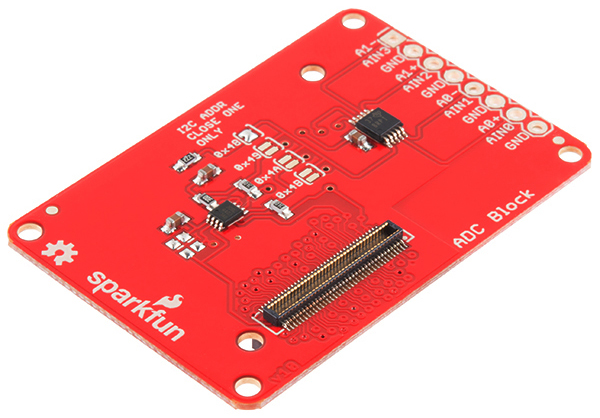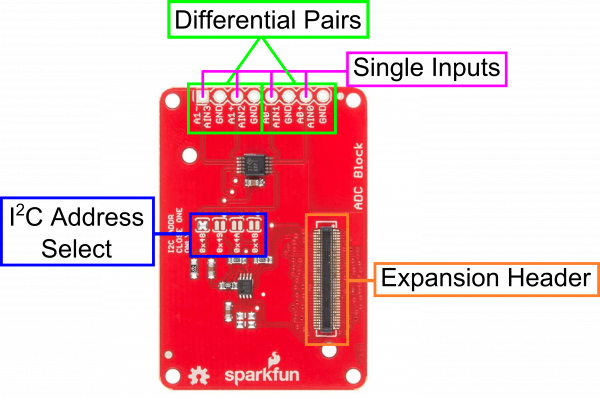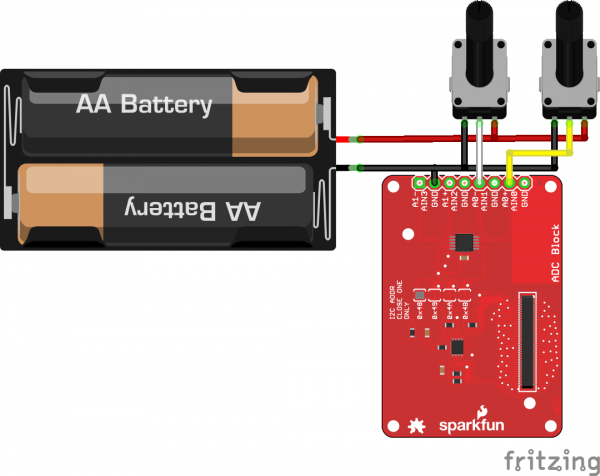SparkFun Blocks for Intel® Edison - ADC
This Tutorial is Retired!
This tutorial covers concepts or technologies that are no longer current. It's still here for you to read and enjoy, but may not be as useful as our newest tutorials.
Introduction
SparkFun’s ADC Block for the Intel Edison allows you to add four channels of I2C controlled ADC input to your Edison stack. These four channels can be used as single-ended inputs, or in pairs as differential inputs. A ground reference is provided for each channel.
The maximum resolution of the converters is 12 bits, or 11 bits bipolar in differential mode. Step sizes range from 125uV per count to 3mV per count.
Suggested Reading
If you are unfamiliar with Blocks, take a look at the General Guide to Sparkfun Blocks for Intel Edison.
Other tutorials that may help you on your Edison adventure include:
- Programming the Edison - This tutorial assumes you are not using the Arduino IDE, so you'll want to familiarize yourself with C++ development on the Edison.
- Powering Your Project
- Connector Basics
- Analog-to-digital conversion
Board Overview
Single Inputs - Four single inputs are available. The reference voltage for each is produced internal to the ADC.
Differential Pairs - Use two inputs to create a differential pair. Useful for eliminating noise in some sensors.
I2C Address Select - Apply solder to (only) one of the four jumpers to select the address.
Expansion Header - The 70-pin Expansion header breaks out the functionality of the Intel Edison. This header also passes signals and power throughout the stack. These function much like an Arduino Shield.
Using the ADC Block
To use the ADC Block simply attach an Intel Edison to the back of the board or add it to your current stack. Blocks can be stacked without hardware but it leaves the expansion connectors unprotected from mechanical stress.
We have a nice Hardware Pack available that gives enough hardware to secure three blocks and an Edison.
NOTE: The ADC Block does not have console access or a voltage regulator. It is recommended to use a console communication block in conjunction with this block like ones found in the General Guide to Sparkfun Blocks for Intel Edison.
C++ Code Examples
We're assuming that you're using the Eclipse IDE as detailed in our Beyond Arduino tutorial. If you aren't, you'll need to go to that tutorial to get up to speed.
Getting Started
Follow the instructions in the programming tutorial to create a new project named "SparkFun_ADC_Edison_Block_Example". Once you've created the project, open the project files on disk (hint: you can find the path to the project by choosing "Properites" from the project menu) and copy the three source files found in the Edison ADC Block CPP library GitHub repository into the "src" directory.
Download a zip file of the repositoryHardware Connection
For this example, we've just got two 5k potentiometers connected between 3.0V and GND, with the wipers connected to channels 0 and 1.
Since the v10 ADC block only has ground references, we're using two AA batteries to provide an external bias voltage for the potentiometers. Other sources with self-contained power supplies will not need this.
Of course, you can connect any other analog voltage signal in place of the potentiometers; we're using them because they're convenient to demonstrate the concepts.
Code
Everything you need to know is in the comments.
/****************************************************************
Example file for SparkFun ADC Edison Block Support
1 Jun 2015- Mike Hord, SparkFun Electronics
Code developed in Intel's Eclipse IOT-DK
This code requires the Intel mraa library to function; for more
information see https://github.com/intel-iot-devkit/mraa
This code is beerware; if you use it, please buy me (or any other
SparkFun employee) a cold beverage next time you run into one of
us at the local.
****************************************************************/
#include "mraa.hpp"
#include <iostream>
#include <unistd.h>
#include "SparkFunADS1015.h"
using namespace std;
// Declare a variable for our i2c object. You can create an
// arbitrary number of these, and pass them to however many
// slave devices you wish.
mraa::I2c* adc_i2c;
int main()
{
// The ADC is (by default) connected to I2C channel 1. Here, we create
// a device to pass to the ads1015 object constructor.
adc_i2c = new mraa::I2c(1);
// Now, pass that I2C object and the address of the ADC block in your
// system to the ads1015 object constructor. Note that there are up to
// four different addresses available here, settable by jumper on the
// board. You'll need to create an ads1015 object for each one.
ads1015 adc(adc_i2c, 0x48);
// There are 6 settable ranges:
// _0_256V - Range is -0.256V to 0.255875V, and step size is 125uV.
// _0_512V - Range is -0.512V to 0.51175V, and step size is 250uV.
// _1_024V - Range is -1.024V to 1.0235V, and step size is 500uV.
// _2_048V - Range is -2.048V to 2.047V, and step size is 1mV.
// _4_096V - Range is -4.096V to 4.094V, and step size is 2mV.
// _6_144V - Range is -6.144V to 6.141V, and step size is 3mV.
// The default setting is _2_048V.
// NB!!! Just because FS reading is > 3.3V doesn't mean you can take an
// input above 3.3V! Keep your input voltages below 3.3V to avoid damage!
adc.setRange(_0_512V);
// getResult() returns a normalized floating point value representing the
// current voltage of the passed channel. User is responsible for
// logic to determine whether the value is at min or max.
cout<<"Ch 0: "<<adc.getResult(0)<<endl;
cout<<"Ch 1: "<<adc.getResult(1)<<endl;
// getDiffResult() returns a normalized fp value representing the
// difference between two channels. Options are
// 0 - Ch0 - Ch1
// 1 - Ch0 - Ch3
// 2 - Ch1 - Ch3
// 3 - Ch2 - Ch3
cout<<"Ch 0 - ch 1: "<<adc.getDiffResult(0)<<endl;
// If you want to do the math yourself, you can determine the current gain
// setting by using the getScaler() command.
cout<<"Current scaler: "<<adc.getScaler()<<"V per bit"<<endl;
// The current voltage is the scaler/1000 multiplied by the raw value. You
// can get the raw ADC readings using the getRawResult() and
// getRawDiffResult() functions.
cout<<"Ch 0 raw: "<<adc.getRawResult(0)<<endl;
cout<<"Ch 1 raw: "<<adc.getRawResult(1)<<endl;
cout<<"Ch 0 - ch 1 raw: "<<adc.getRawDiffResult(0)<<endl;
// If you want to get *really* crazy, you can always go look up the
// datasheet and read and write the configuration register directly.
cout<<"Config register: "<<hex<<adc.getConfigRegister()<<endl;
// There's a "setConfigRegister()" function, too, which expects an
// unsigned 16-bit integer. Just FYI.
return MRAA_SUCCESS;
}
Resources and Going Further
Now that you have had a brief overview of the ADC Block, take a look at some of these other tutorials. These tutorials cover programming, Block stacking, and interfacing with the Intel Edison ecosystems.
Edison General Topics:
- General Guide to Sparkfun Blocks for Intel Edison
- Edison Getting Started Guide
- Loading Debian (Ubilinix) on the Edison
Block Specific Topics:
Check out these other Edison related tutorials from SparkFun:




